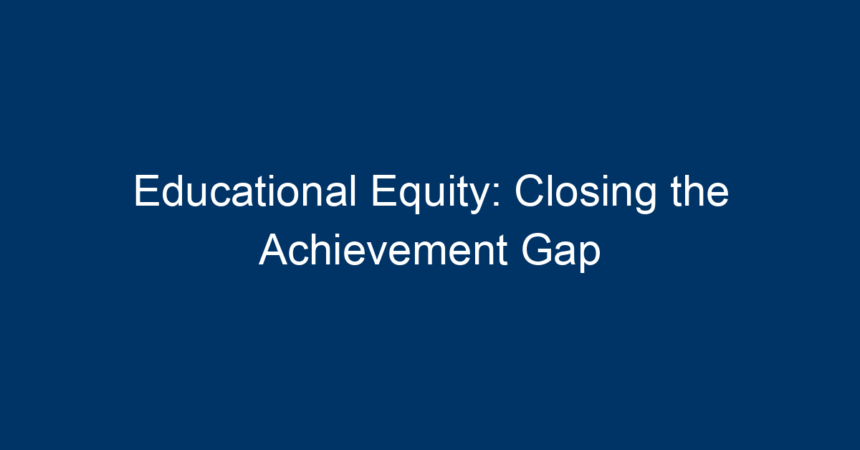Introduction
In an era where education is often touted as the great equalizer, the persistent achievement gap between various demographics highlights a stark reality—educational equity remains a distant goal for many. The notion of educational equity involves ensuring that every student, regardless of their background, has access to quality education and the necessary resources to succeed. However, disparities rooted in socioeconomic status, race, and geographic location continue to foster unequal educational opportunities. This article explores the concept of educational equity, delving into its implications, challenges, and actionable strategies to close the achievement gap.
Understanding Educational Equity
Defining Educational Equity
Educational equity is about fairness in educational opportunities. It recognizes that students come from diverse backgrounds and possess varying needs. Unlike equality, which treats every student the same regardless of their unique challenges, educational equity aims to tailor resources and support to meet individual needs effectively. This nuanced approach acknowledges systemic barriers and aims to dismantle them, ensuring that all students can thrive academically.
The Importance of Addressing the Achievement Gap
The achievement gap refers to the disparity in academic performance between groups of students, particularly those defined by race, ethnicity, and socioeconomic status. Addressing this gap is crucial not only for the individuals affected but also for society as a whole:
-
Economic Growth: A well-educated workforce drives economic progress. Bridging the achievement gap can contribute to a more skilled labor market.
-
Social Justice: Educational equity is a matter of fairness. Ensuring equal access to quality education is fundamental to an equitable society.
- Community Development: Schools often serve as community hubs. Addressing inequities in education can lead to stronger, more resilient communities.
The Root Causes of the Achievement Gap
Understanding the underlying causes of the achievement gap is critical for creating effective solutions. Here are some of the key factors:
Socioeconomic Disparities
Students from low-income families often face numerous challenges, including lack of access to educational resources, inadequate nutrition, and limited opportunities for enrichment activities. These obstacles can hinder academic performance and contribute to widening the achievement gap.
Racial and Ethnic Inequality
Discrimination and historical inequalities play significant roles in the educational landscape. Students of color, for example, may encounter bias in school settings, face harsher disciplinary actions, or attend underfunded schools, all of which impact their educational outcomes.
Geographic Disparities
Geographic location can also influence educational access. Students in rural areas may have fewer resources, limited access to advanced courses, and inadequate technology, while urban students might suffer from overcrowded classrooms and under-resourced schools.
Strategies to Promote Educational Equity
Addressing the achievement gap requires a multi-faceted approach. Here are several actionable strategies to promote educational equity:
1. Resource Allocation and Funding Reforms
Equitable Funding Models
One of the first steps towards achieving educational equity involves reforming funding models to ensure that resources are allocated based on need rather than property taxes. Schools in disadvantaged areas should receive additional funding to provide the necessary support and resources.
Investing in Quality Educators
Hiring and retaining high-quality educators in underserved areas can make a significant difference. Offering competitive salaries, professional development, and support systems can attract skilled teachers to schools that need them most.
2. Early Childhood Education Programs
Investing in early childhood education is crucial for setting the foundation for future academic success. Programs that offer accessible, high-quality early education can help level the playing field for children from disadvantaged backgrounds.
3. Culturally Relevant Curriculum
Developing a culturally relevant curriculum can help students feel seen and valued in their educational environment. When students can connect their learning to their own lives and experiences, it fosters engagement and promotes better academic outcomes.
4. Community Engagement and Support
Building Stronger Partnerships
Engaging with families, local businesses, and community organizations can create a support network that champions educational equity. Schools that collaborate with their communities can identify needs and co-create solutions.
Parental Involvement Programs
Encouraging parental involvement through workshops, meetings, and events can empower families to take an active role in their children’s education. Support systems for parents can also help them navigate challenges and advocate for their children effectively.
5. Mentorship and Tutoring Programs
Establishing mentorship and tutoring programs can provide students with the additional support they need to succeed academically. These programs can connect students with role models and academic resources that enhance their learning experience.
Measuring Progress Toward Educational Equity
Progress in achieving educational equity must be monitored through various metrics:
Data Collection and Analysis
Schools and policymakers should collect and analyze data on academic performance, attendance rates, and disciplinary actions across different demographics. This data can help identify disparities and target interventions more effectively.
Setting Clear Goals
Establishing clear, measurable goals for closing the achievement gap can help hold schools accountable. Regular assessment of progress toward these goals can ensure that efforts remain focused and effective.
Community Feedback
Gathering feedback from students, parents, and community members can provide valuable insights into the effectiveness of equity initiatives. This input can guide future strategies and ensure that they align with the needs of the community.
Conclusion: A Call to Action
Closing the achievement gap and promoting educational equity is a shared responsibility that requires collaboration among educators, policymakers, families, and communities. By understanding the root causes of the achievement gap and implementing targeted strategies, we can create a more equitable education system for all students.
Actionable Insights
-
Advocate for Funding Reforms: Get involved in local advocacy efforts to push for equitable funding for schools in under-resourced areas.
-
Support Early Education: Encourage and support initiatives that promote access to high-quality early childhood education programs.
-
Engage with Schools: Participate in school events and parent-teacher meetings to stay informed and involved in your child’s education.
-
Share Resources: If you have resources or expertise, consider mentoring students or volunteering in tutoring programs.
- Promote Awareness: Raise awareness about educational equity issues in your community through discussions, social media, and local events.
Together, we can build a more equitable education system that empowers every student to succeed, regardless of their background. Let’s take action today to close the achievement gap!




